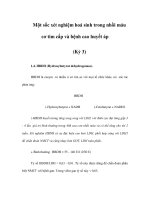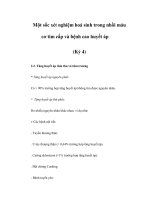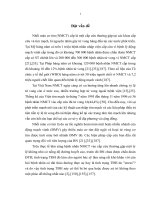Giá trị tiên lượng của h FABP trong nhồi máu cơ tim cấp
Bạn đang xem bản rút gọn của tài liệu. Xem và tải ngay bản đầy đủ của tài liệu tại đây (1.62 MB, 38 trang )
PROGNOSTIC VALUE
OF H-FABP, A NEW MARKER
IN ACUTE MYOCARDIAL INFARCTION
Dr. GIAO THI THOA- Đa Nang Hopital
A/ Prof. NGUYEN LAN HIEU- Ha Noi Medical University
Prof. HUYNH VAN MINH- Hue University of Medicine and Pharmacy
Deaths from Cardiovascular disease have been declining in developed nations
but have increased in low- and middle-income countries.
Over 80% of the world's CVD deaths now occur in developing nations.
Currently, heart disease is the biggest health threat to humans.
Among them, AMI is one of the leading causes of death and disability.
Non ACS diagnosis? Stable Angina? Unstable Angina? NSTEMI?
Despite the development of cardiac centers and theories of high sensitivity and
specificity of biomarkers in myocardial necrosis. The evaluation of unexplained
chest pain symptoms remains a huge challenge.
ACS Biomarker Development
In order to improve the accuracy and effectiveness of diagnosis of MI, clinical
researchers have discovered a new type of cardiac enzyme called H-FABP
(Heart-type Fatty Acid Binding Protein).
Moriates C, Maisel A.( 2010), “The utility of biomarkers in sorting out the complex patient”, Am J Med, 123(5), pp.393-9
Displays an array of biomarkers of different stages of cardiac disease.
H-FABP was first shown to be released from injured myocardium in 1988,
after which its application as a biochemical marker has been investigated.
H-FABP is the quickest marker for diagnosis of MI in the early stage when ECG
is unclear.
• H-FABP is a small, cytoplasmic protein
• Molecular weight of only 15 kDa
• 20 times more cardiac specific than
Myoglobin
H-FABP has demonstrated its outstanding capabilities of sensitivity and
specificity, superior to troponin, particularly in the earliest stages of 0-6 hours.
Within only 30 minutes after onset of AMI, H-FABP became detectable in
blood and increased very quickly.
The Prognostic Value
INTRODUCTION
Viswanathan K, Kilcullen N, Morrell C, Thistlethwaite SJ, Sivananthan MU, Hassan TB, Barth JH, Hall AS. heart-type fatty-acid
binding-protein (H-FABP) predicts long-term mortality and re-infarction in consecutive patients with suspected acute
coronary syndrome who are troponin negative. J. Am. Coll. Cardiol. 2010;55(23): 2590-8
An increased concentration of H-FABP in the early stage after chest pain
demonstrated a reliable prognostic value of death and cardiovascular
events after AMI.
INTRODUCTION
H-FABP contributed to providing valuable information for prognostic of
AMI, independent of Troponin T, ECG and clinical tests.
Kilcullen N, Viswanathan K, Das R, Morrell C, Farrin A, Barth JH, Hall AS; Heart-type fatty acid-binding protein predicts long-term mortality after acute
coronary syndrome and identifies high-risk patients across the range of troponin values. J. Am. Coll. Cardiol. 2007;50(21):2061-7..
To learn about the application of this cardiac enzyme, our selected research
topic is "Prognostic value of H-FABP, a new marker in acute myocardial
infarction".
AIMS
1/To evaluate variation of the level of H-FABP in
patients with acute myocardial infarction before 6 hours
and after 24 hours.
2/ To determine the relationship between the level of HFABP and Killip class & early complications in acute
myocardial infarction.
PATIENT SELECTION CRITERIA
The target group included:
-
Patients with clinical manifestations and ECG for
suspected AMI
- Hospitalized before 24 hours after symptom onset
- At Da Nang Hospital from June 2013 throughout June
2014.
EXCLUSION CRITERIA
The following patients were excluded from the
study group:
- Patients with kidney disease.
- Pulmonary embolism
EXCLUSION CRITERIA
- Brain injury
- Musculoskeletal injuries
- Patients admitted to hospital late after 24 hours
since symptom onset.
RESEARCH METHODOLOGY
- The prospective, cross-sectional study was applied.
- Each patient was surveyed in the following process:
being asked about his medical history and having
clinical examinations with an aim to selecting a target
group in line with the study standards.
RESEARCH METHODOLOGY
- Blood tests were taken in accordance with
the regulations, diagnostic steps were
conducted at a reliable specialist center.
- All data were recorded on paper sheets.
Baseline Characteristics
Characteristics
≤ 60
Age
> 60
Male
Sex
Female
≤ 6 hours
Onset of illness
> 6 hours
Length of hospitalization (day)
Total
n
26
36
46
16
19
43
%
41.9
58.1
74.2
25.8
30.6
69.4
X ± SD
65.74±14.5
9.65±5.1
62
100.0
The average age of the target group was 65.74, among which over-60s
made up a greater percent 58.1 %.
Male patients accounted for 74.2%.
Baseline Characteristics
Characteristics
≤ 60
Age
> 60
Male
Sex
Female
≤ 6 hours
Onset of illness
> 6 hours
Length of hospitalization (day)
Total
n
26
36
46
16
19
43
%
41.9
58.1
74.2
25.8
30.6
69.4
X ± SD
65.74±14.5
9.65±5.1
62
100.0
The number of patients hospitalized prior to 6 hours since symptom onset
made up 30.6%.
The average length of stay at hospital was 9.65 days.
Similar to the findings of some national and international studies.
Baseline Characteristics
Risk factors
Frequency (n =62)
Percent (%)
X ± SD
Dyslipidemia
32
51.6
70.23±134.8
Hypertension
36
58.1
101.25±142.5
Diabetes
12
19.4
97.37±95.9
Obesity
12
19.4
105.74±117.5
Smoking
34
54.8
124.92±244.3
The number of patients with hypertension was the highest at 58.1%,
followed by patients with smoking at 54.8%.
However, the average levels of H-FABP in the smoking group was higher
than the hypertension group.
Levels of CK, CK MB, Troponin T, myoglobin,
NT pro BNP, H-FABP measured for the first time
Onset of AMI
Level
CK
CK-MB
Troponin T *
NT-proBNP*
Myoglobin
H-FABP *
1-6h (n = 27)
7-12h (n = 9)
13-24h (n = 26)
232 ± 41,7
41,26±7,2
0,74±0,6
1956,89±653,5
35,30±147,7
157,75±55,64
1409,50±697,9
135,34±57,6
1,03±0,4
1861,42±1200,6
1604,25±227,5
384,82±98,4
2805±775,78
210±48,5
18,12±14,2
4975,79±1942,7
506,83±164,9
93,11±25,3
The level of biomarkers such as Troponin, NT-proBNP, and H-FABP
changed over time and was accepted as statistically significant.









